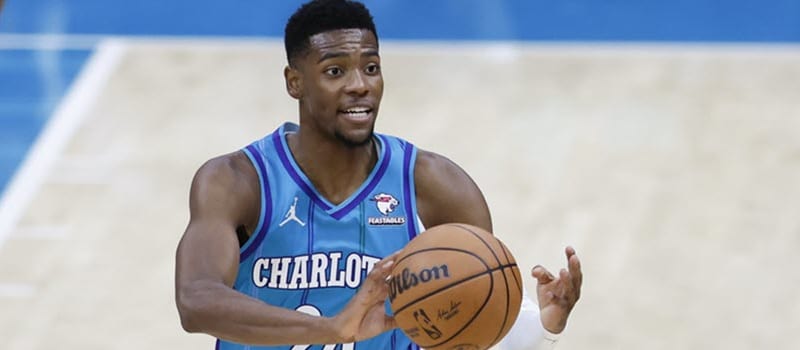


There is a wealth of information and tips available to aid you in making the best picks in fantasy basketball. Many of those are available to you on RotoWire in the forms of fantasy basketball rankings, fantasy basketball projections, and even our fantasy basketball videos.
But with so many different fantasy basketball league formats, I sought to create a fantasy basketball draft strategy that could be used almost universally. The main question being: What makes a great fantasy basketball pick? What player qualities are we searching for?
Does the team trust this player to create offense?
Tip: You should aim to draft players who are clear Top 3 options on their team. When one (or two) of these players inevitably suffers an injury, the other two will pick up most of the slack. Usage doesn’t often get distributed evenly across a roster. If the hierarchy isn’t a defined Big 3, you can generally use a statistical rule of thumb. If a player averages 25+ combined points and assists, they qualify. If it’s closer to 20+ points and assists, it’s more case-by-case.
Notes
Has this player proven the ability to stay on the court?
Tip: How you define “injury prone” carries a lot of weight, so this is where my cheat sheet and your cheat sheet may look quite different. I’m classifying injury-prone as someone who has 5+ seasons of fewer than 65 games played (the NBA’s own definition of “too injured”). In my opinion, this appropriately gives more leeway to younger players who have had fewer cumulative injuries and can recover faster. It also punishes older players who have compounding injuries and can’t recover as quickly. Age and injury are closely tied together.
Here is a list of players and the amount of seasons they have with fewer than 65 games played. See if you agree with my definition of injury-prone:
Notes
Is this player at risk of physical decline?
Tip: What is old? I did quick research on this, which I’ll include below. But I’ve come to the conclusion that 33+ years old should raise red flags. To reach this conclusion, I took data from the last three seasons. Starting with age 30, I counted the number of players by age who played 65+ games and saw at least 24+ minutes per game.
2021-22
2022-23
2023-24
Looking above, the most players present in any age group over 30 years old was 7 – and the oldest age that there were 7 players was age 32. From ages 30-32, there are an average of 5.2 players. From ages 33 onward, there are an average of 2.1 players. Would this statistical argument hold up in court? I don’t know. But I think it does a fine job of confirming that what we feel is old in the NBA is probably the case.
Notes
Should you be worried about tanking?
Tip: If you’ve played fantasy basketball over the past three years – or are even just aware of NBA discourse – you know tanking is a big deal. Phantom back injuries and sore knees plague talented older players on bad teams in March and April. Or, those players get traded to better teams, where they have a smaller role.
Here are some players who missed significant time or had the roles reduced in March or April last year. It isn’t exactly a murderer’s row, but many of these players were drafted inside the top 100:
Six teams played below a 20-win pace from March 15 onward last year. In 2022-23, there were three teams. The year before that, there were four teams.
The DraftKings Sportsbook has eight teams listed at 1,000-to-1 odds to win the title – effectively the biggest tanking risks.
Be careful when drafting players from these teams, especially veterans. Make sure you’re not reaching too far above ADP or what you perceive to be their in-a-vacuum value.
Notes
At what point should you stop worrying about role, injury, age or team success?
Tip: Most of the guidelines above exist to help you avoid downside risk when drafting the core of your team. Later in drafts, you should mostly be focused on upside. Try to draft players who, if they reach their peak, could not be easily replaced off the waiver wire. That will probably require ditching concerns about team success, age and injury. Role still remains crucial.
So, when do you flip the proverbial switch? Anecdotally and statistically, I think the answer is around picks 70-90, or about rounds 6-8 in a standard league. For total fantasy production for standard 8-category roto leagues, the “average” fantasy player based on Z-score ranks in the low-70s. Some players around this range last year included Jusuf Nurkic, Isaiah Hartenstein, Jalen Suggs and Jrue Holiday.
Notes
This will take time, but it’s worth it.
Tip: I’m a Google Sheets man, but any old Excel sheet will work. Find a host platform whose fantasy basketball ADP you trust the most (personally, I prefer Yahoo). Or, start by using RotoWire’s fantasy basketball rankings.
From there, either import that data into your spreadsheet, or just enter players one-by-one if they fit your criteria (role, injury, age, team success). I would separate the cheat sheet into two sections: one for the safer core picks, and one for your favorite riskier late picks typically available after pick 70. Create a duplicate of that sheet, and then use it when you draft by deleting the players’ names as they’re selected. It’s a bit of an inconvenience, but the trade off is that you shouldn’t have to spend as much time thinking about your picks. If you play on a site like Fantrax, you should be able to directly upload your sheet and avoid the deleting names process entirely.
An example of the top of your cheat sheet might look something like this:
Notes
Check out RotoWire’s How to Play Fantasy Basketball guide for a complete walkthrough, but here is some basic advice: